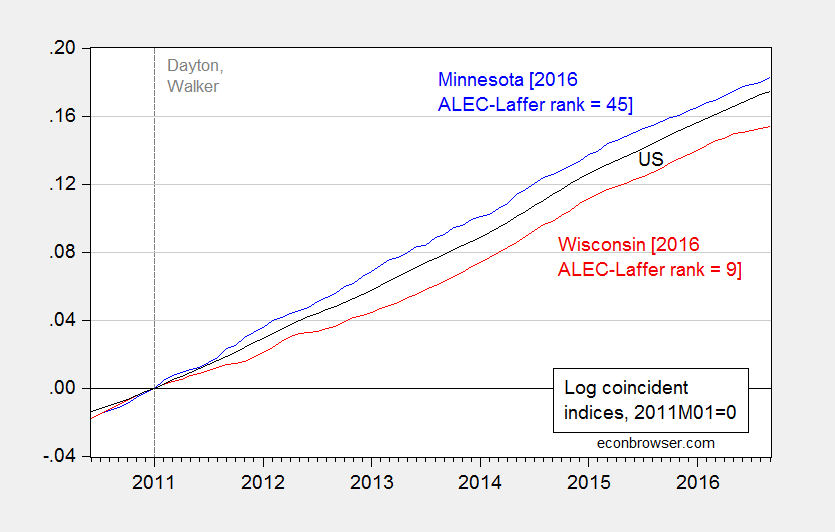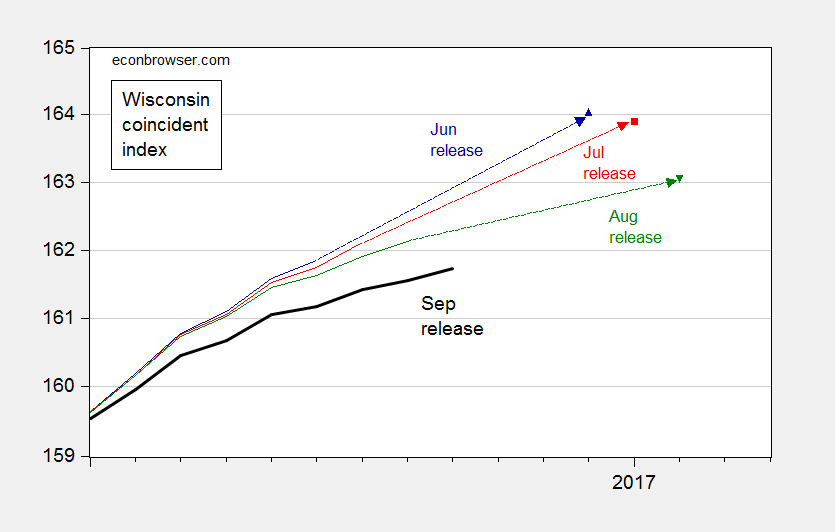In case you were wondering, Minnesota continues to outpace Wisconsin.

Figure 1: Log coincident indices for Minnesota (blue), Wisconsin (red), and US (black), all normalized to 2011M01=0. Source: Philadelphia Fed, ALEC, and author’s calculations.
Notice that highly ranked Wisconsin (ranked 9th in economic outlook according to ALEC’s Rich States, Poor States, 2016) is lagging relative to Minnesota (ranked 45th). While this is merely one observation, as I’ve noted in a previous post, there is almost zero correlation of the ALEC rankings with GDP growth at any horizon, on a cross-state basis.
Note Wisconsin estimated growth is being revised downward over time.

Figure 2: Coincident index from June release (dark blue), from July (red), from August (green), from September (black), and associated six-month ahead implied levels, based on leading indices corresponding to coincident releases. All on log scale. Source: Philadelphia Fed, various releases, author’s calculations.
For discussion of declining employment in Wisconsin, see this post.
While the overall employment levels of the two states are similar, Minnesota is nicely positioned in finance (Federal Reserve) and healthcare (Obamacare) whereas Wisconsin is more dependent on old-line manufacturing. No, I’m not saying that the Federal Reserve and the ACA are employing those people, I’m saying that the relationship of those Federal activities to employment sectors in Minnesota has been significantly more beneficial to Minnesota than Wisconsin.
Wisconsin has suffered from the general stagnation of manufacturing in the U.S. far more than Minnesota which has been a vacuum cleaner for Federal funds. The devil’s in the details.
So…socialism works?
For Larry or the other brother Larry?
Sure, if you’re the one getting the money rather than giving.
Maggie Thatcher had a thought about that.
Yes, it also supports Krugman’s paper. There are 3 1/2 million people in the Twin Cities metro area. It’s the second largest metro area in the Midwest, after Chicago. The two largest cities in Wisconsin are Milwaukee and Madison with less than one million people combined.
They may be cow towns with a lot of hicks. I guess, if you like beer and cheese, it’s a good place to be. Or, if you don’t like milking cows or working at the paper mill, you may want to move somewhere else 🙂
bruce, could you provide some evidence that minnesota is the “vacuum cleaner” of federal funds, especially compared to wisconsin? granted, it is from a couple of years ago, but i have seen evidence that indicates minnesota gets back fewer dollars from the fed than it gives compared to most other states
http://www.theatlantic.com/business/archive/2014/05/which-states-are-givers-and-which-are-takers/361668/
Minnesota doesn’t get direct tax dollars, but the Fed policies and ACA mandates have been proportionally more beneficial to Minnesota corporations (and employees) that Wisconsin’s simply because there are more headquartered companies involved in health care/health care products and banking/finance and less involved in old-line manufacturing which has been more of an anchor on Wisconsin’s growth than Minnesota which has less old-line manufacturing (and showing similar stagnation).
http://archive.jsonline.com/business/wisconsin-manufacturers-caught-in-a-global-slump-b99606604z1-339143531.html
April-September 2016 Data
Minnesota:
Civilian Labor Force (1)
3,069.6 3,062.4 3,044.2 3,021.6 3,003.3 (P) 2,993.7
Manufacturing (3)
318.6 316.4 317.7 317.1 316.6 (P) 317.3
12-month % change
0.4 -0.3 0.4 0.3 0.2 (P) 0.4
Wisconsin:
Civilian Labor Force (1)
3,144.1 3,140.5 3,132.1 3,125.5 3,127.9 (P) 3,132.3
Manufacturing (3)
470.9 471.8 474.1 471.9 470.9 (P) 470.8
12-month % change
0.6 1.0 1.4 0.9 0.8 (P) 0.8
Bruce Hall – how you explain the divergence — because Obamacare — is really rather hilarious. The first open enrollment period was from Oct 2013 to April 2014. The divergence began in 2011.
And the Federal Reserve Bank? Is their business suddenly booming? They have 1064 employees per the 2015 report to congress; they had 1012 in the 2010 report. They’ve added 50 employees in five-years and you find that significant? Ideology is better than psychotropic drugs for making one see pink elephants.
And of course not all those employees live in or work in MN. These are *regional* banks. Do you start these uneducated memes or do you regurgitate them from someplace else?
Obviously, you did not read what I wrote. But that’s okay. I’m ignoring your response.
But I’ll give you a hint: policies and mandates; positioning of sectors… Minnesota versus Wisconsin.
Bruce Hall,
You’re making the same mistake here that you made with Kansas. The Federal Reserve was in the Twin Cities area long before Scott Walker became governor of Wisconsin. That’s a fixed effect and does not affect the change in the growth rates between MN and WI. So even if we were to accept your convoluted hypothesis about the employment and growth effects of having a Federal Reserve bank in the Twin Cities, that doesn’t explain the different growth rates today.
Now you might have a point with respect to the ACA…but that point makes Walker look even worse. Wisconsin is one of the states that’s dragged its feet on expanding Medicaid. Minnesota is fully on board with the ACA. Declining participation in expanded Medicaid under the ACA has a direct negative effect on state GDP. But that’s something that Walker and his GOP friends in the state legislature deliberately chose. So it’s entirely fair and appropriate to hang this blunder around Walker’s neck.
My points had nothing to do with the location of the Fed or how many employees it had; neither did it have anything to do with the number of people on Medicaid. Rather I wrote about the effect of Fed policies which helped the finance sector and, you might note, Minneapolis is home to the 8th largest bank in the U.S. whereas Wisconsin is modestly represented in that sector. Likewise, Minnesota is home to Medtronic which has benefitted greatly from the expansion of insurance coverage whereas Wisconsin has nothing really comparable.
On the other hand, both states have had meager growth in the industrial/manufacturing arena with Wisconsin being hit particularly hard by the global slowdown with companies like Caterpillar and by having a significantly larger sector than Minnesota.
So, I guess you’re right. Walker is to blame. Hmmm. But by that logic, if there had been a global construction boom and Wisconsin benefitted by that, then Walker would have been a genius. Right?